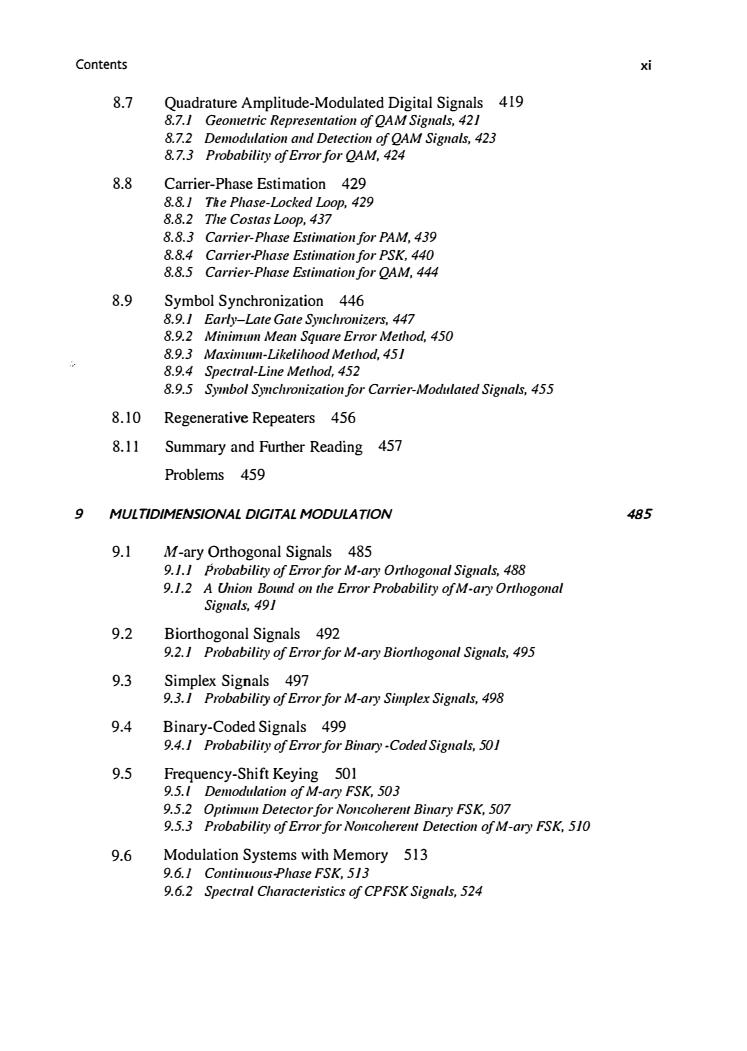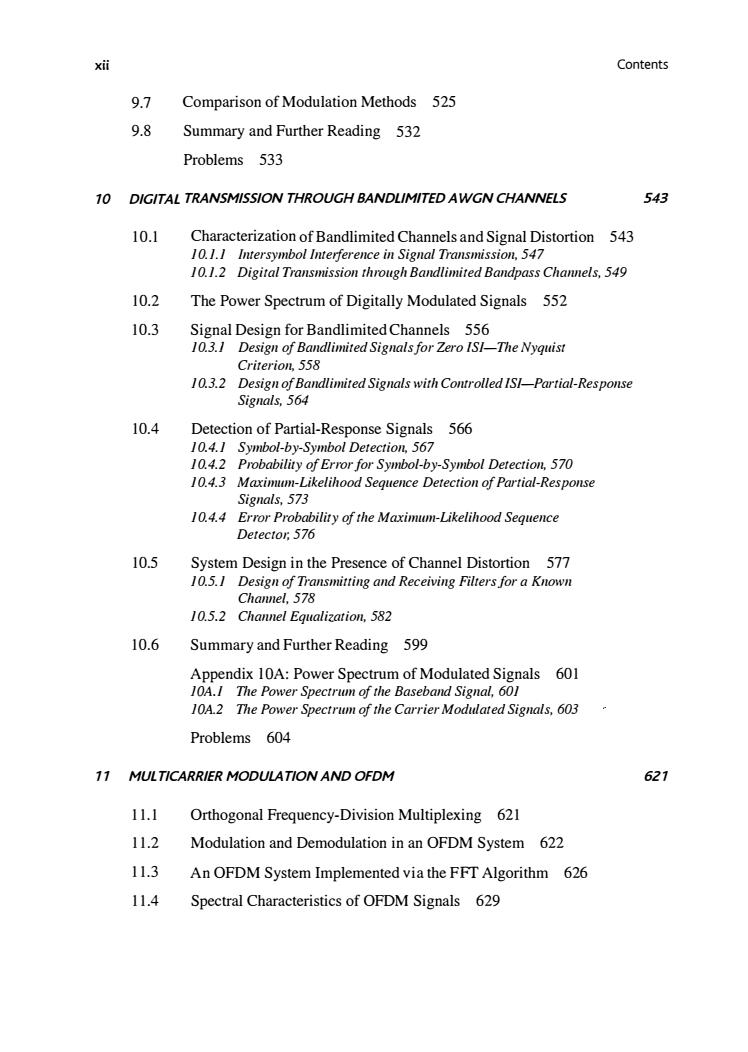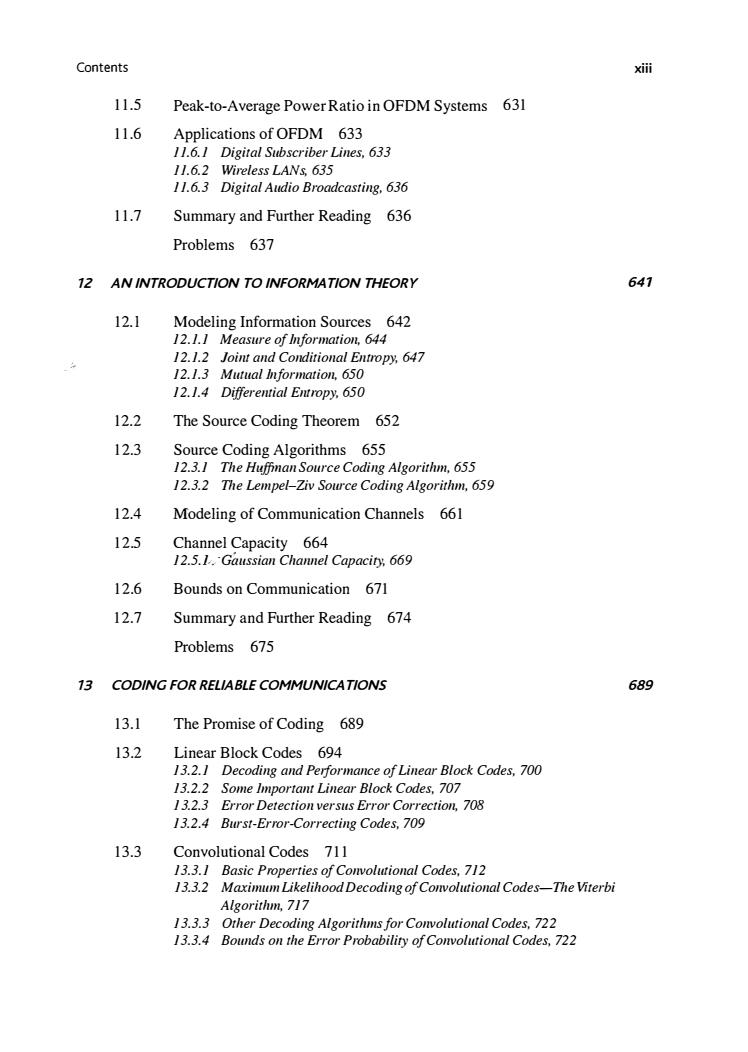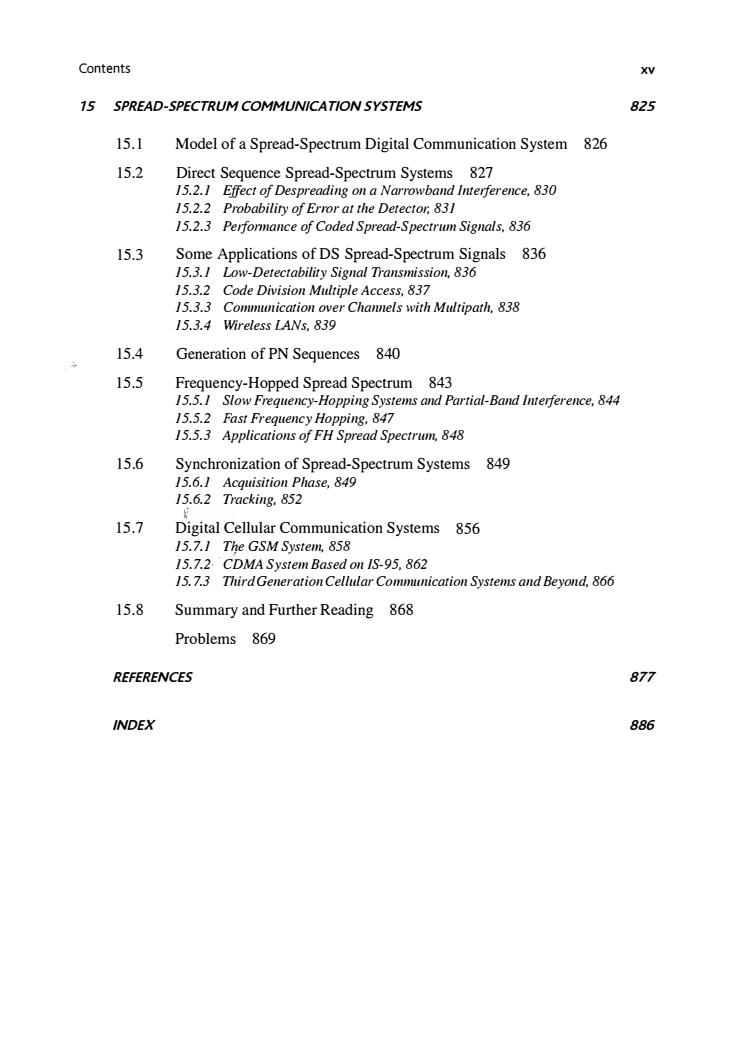
Contents xi 8.7 Quadrature Amplitude-Modulated Digital Signals 419 8.7.1 Geometric Representation of QAM Signals,421 8.7.2 Demodulation and Detection of OAM Signals,423 8.7.3 Probability of Error for QAM,424 8.8 Carrier-Phase Estimation 429 8.8.1 The Phase-Locked Loop,429 8.8.2 The Costas Loop,437 8.8.3 Carrier-Phase Estimation for PAM,439 8.8.4 Carrier-Phase Estimation for PSK,440 8.8.5 Carrier-Phase Estimation for OAM,444 8.9 Symbol Synchronization 446 8.9.1 Early-Late Gate Synchronizers,447 8.9.2 Minimtmn Mean Square Error Method,450 8.9.3 Maximum-Likelihood Method,451 8.9.4 Spectral-Line Method,452 8.9.5 Symbol Synchronization for Carrier-Modulated Signals,455 8.10 Regenerative Repeaters 456 8.11 Summary and Further Reading 457 Problems 459 9 MULTIDIMENSIONAL DIGITAL MODULATION 485 9.1 M-ary Orthogonal Signals 485 9.1.1 Probability of Error for M-ary Orthogonal Signals,488 9.1.2 A Union Bound on the Error Probability of M-ary Orthogonal Signals,491 9.2 Biorthogonal Signals 492 9.2.1 Probability of Error for M-ary Biorthogonal Signals,495 9.3 Simplex Signals 497 9.3.1 Probability of Error for M-ary Simplex Signals,498 9.4 Binary-Coded Signals 499 9.4.1 Probability of Error for Binary-Coded Signals,501 9.5 Frequency-Shift Keying 501 9.5.1 Demodulation of M-ary FSK,503 9.5.2 Optimumn Detector for Noncoherent Binary FSK,507 9.5.3 Probability of Error for Noncoherent Detection of M-ary FSK,510 9.6 Modulation Systems with Memory 513 9.6.1 Continuous-Phase FSK,513 9.6.2 Spectral Characteristics of CPFSK Signals,524
Contents 9 8.7 Quadrature Amplitude-Modulated Digital Signals 419 8.7.1 Geo111etric Represe11tation of QAM Signals, 421 8.7.2 De1110.d11latio11 and Detection of QAM Signals, 423 8. 7.3 Probability of Error/or QAM, 424 8.8 Carrier-Phase Estimation 429 8.8. I Tile Phase-Locked Loop, 429 8.8.2 Tile Costas Loop, 437 8.8.3 Carrier- Phase Esti111atio11 for PAM, 439 8.8.4 Carrier-Phase Estilnation for PSK, 440 8.8.5 Carrier-Phase Esti111ation for QAM, 444 8.9 Symbol Synchronization 446 8.9.1 Early-Late Gate Sy11chro11izers, 447 8.9.2 Mini11111111 Mean Square Error Method, 450 8.9.3 Maxilnu111-Likelihood Method, 451 8.9.4 Spectral-Line Method, 452 8.9.5 Sy111bol Synchronization for Carrier-Modulated Sig11als, 455 8.10 Regenerative Repeaters 456 8.11 Summary and Further Reading 457 Problems 459 MUL T/DIMENSIONAL DIGITAL MODULA T/ON 9 .1 M -ary Orthogonal Signals 485 9.1.1 Probability of Error for M-ary Orthogonal Signals, 488 9.1.2 A Union Bound on the Error Probability of M-a1y Orthogonal Signals, 491 9.2 Biorthogonal Signals 492 9.2.1 Probability of Envr for M-a1y Biorthogonal Signals, 495 9.3 Simplex Signals 497 9.3.1 Probability of Error for M-ary SiJnplex Signals, 498 9.4 Binary-Coded Signals 499 9.4.1 P1vbability of Error for Bina1y-Coded Signals, 501 9.5 Frequency-Shift Keying 501 9.5. l Den1odulation of M-ary FSK, 503 9.5.2 Opti1111on Detector for Noncoherent Binary FSK, 507 9.5.3 Probability of Error for Noocoherent Detection of M-a1y FSK, 510 9.6 Modulation Systems with Memory 513 9.6.J Continuous-Phase FSK, 513 9.6.2 Spectral Characteristics of C PFSK Signals, 524 xi 485

xii Contents 9.7 Comparison of Modulation Methods 525 9.8 Summary and Further Reading 532 Problems 533 10 DIGITAL TRANSMISSION THROUGH BANDLIMITED AWGN CHANNELS 543 10.1 Characterization of Bandlimited Channels and Signal Distortion 543 10.1.1 Intersymbol Interference in Signal Transmission,547 10.1.2 Digital Transmission through Bandlimited Bandpass Channels,549 10.2 The Power Spectrum of Digitally Modulated Signals 552 10.3 Signal Design for Bandlimited Channels 556 10.3.1 Design of Bandlimited Signals for Zero ISI-The Nyquist Criterion,558 10.3.2 Design of Bandlimited Signals with Controlled ISI-Partial-Response Signals,564 10.4 Detection of Partial-Response Signals 566 10.4.1 Symbol-by-Symbol Detection,567 10.4.2 Probability of Error for Symbol-by-Symbol Detection,570 10.4.3 Maximum-Likelihood Sequence Detection of Partial-Response Signals,573 10.4.4 Error Probability of the Maximum-Likelihood Sequence Detector,576 10.5 System Design in the Presence of Channel Distortion 577 10.5.1 Design of Transmitting and Receiving Filters for a Known Channel,578 10.5.2 Channel Egualization,582 10.6 Summary and Further Reading 599 Appendix 10A:Power Spectrum of Modulated Signals 601 10A.I The Power Spectrum of the Baseband Signal,601 10A.2 The Power Spectrum of the Carrier Modulated Signals,603 Problems 604 11 MULTICARRIER MODULATION AND OFDM 621 11.1 Orthogonal Frequency-Division Multiplexing 621 11.2 Modulation and Demodulation in an OFDM System 622 11.3 An OFDM System Implemented via the FFT Algorithm 626 11.4 Spectral Characteristics of OFDM Signals 629
xii Contents 9.7 Comparison of Modulation Methods 525 9.8 Summary and Further Reading 532 Problems 533 10 DIGITAL TRANSMISSION THROUGH BANDLIM/TED A WGN CHANNELS 10.1 Characterization of Bandlimited Channels and Signal Distortion 543 10.1.1 lntersymbol lnteiference in Signal Transmission, 547 10.1.2 Digital Transmission through Bandlimited Bandpass Channels, 549 10.2 The Power Spectrum of Digitally Modulated Signals 552 10.3 Signal Design for Bandlimited Channels 556 10.3.l Design of Bandlimited Signals for Zero !SI-The Nyquist Criterion, 558 10.3.2 Design of Bandlimited Signals with Controlled !SI-Partial-Response Signals, 564 10.4 Detection of Partial-Response Signals 566 10.4.1 Symbol-by-Symbol Detection, 567 10.4.2 Probability of Error.for Symbol-by-Symbol Detection, 570 10.4.3 Maximum-Likelihood Sequence Detection of Partial-Response Signals, 573 10.4.4 Error Probability of the Maximum-Likelihood Sequence Detect01; 576 10.5 System Design in the Presence of Channel Distortion 577 10.5.1 Design of Transmitting and Receiving Filters. for a Known Channel, 578 10.5.2 Channel Equalization, 582 10.6 Summary and Further Reading 599 Appendix lOA: Power Spectrum of Modulated Signals 601 JOA.I The Power Spectrum of the Baseband Signal, 601 JOA.2 The Power Spectrum of the Carrier Modulated Signals, 603 Problems 604 11 MUL TICARRIER MODULATION AND OFDM 1 1.1 Orthogonal Frequency-Division Multiplexing 621 11.2 Modulation and Demodulation in an OFDM System 622 1 1.3 An OFDM System Implemented via the FFT Algorithm 626 11.4 Spectral Characteristics of OFDM Signals 629 543 621

Contents xiii 11.5 Peak-to-Average Power Ratio in OFDM Systems 631 11.6 Applications of OFDM 633 11.6.1 Digital Subscriber Lines,633 11.6.2 Wireless LANs,635 11.6.3 Digital Audio Broadcasting,636 11.7 Summary and Further Reading 636 Problems 637 12 AN INTRODUCTION TO INFORMATION THEORY 647 12.1 Modeling Information Sources 642 12.1.1 Measure of Information,644 12.1.2 Joint and Conditional Entropy,647 12.1.3 Mutual Information,650 12.1.4 Differential Entropy,650 12.2 The Source Coding Theorem 652 12.3 Source Coding Algorithms 655 12.3.1 The Huffinan Source Coding Algorithm,655 12.3.2 The Lempel-Ziv Source Coding Algorithm,659 12.4 Modeling of Communication Channels 661 12.5 Channel Capacity 664 12.5.1.Gaussian Channel Capaciry,669 12.6 Bounds on Communication 671 12.7 Summary and Further Reading 674 Problems 675 13 CODING FOR RELIABLE COMMUNICATIONS 689 13.1 The Promise of Coding 689 13.2 Linear Block Codes 694 13.2.1 Decoding and Performance of Linear Block Codes,700 13.2.2 Some Important Linear Block Codes,707 13.2.3 Error Detection versus Error Correction,708 13.2.4 Burst-Error-Correcting Codes,709 13.3 Convolutional Codes 711 13.3.1 Basic Properties of Convolutional Codes,712 13.3.2 Maximum Likelihood Decoding of Convolutional Codes-The Viterbi Algorithm,717 13.3.3 Other Decoding Algorithms for Convolutional Codes,722 13.3.4 Bounds on the Error Probabiliry of Convolutional Codes,722
Contents 11.5 Peak-to-Average Power Ratio in OFDM Systems 631 11.6 Applications of OFDM 633 I I.6.I Digital Subscriber Lines, 633 I I.6.2 Wireless LANs, 635 I I.6.3 Digital Audio Broadcasting, 636 11. 7 Summary and Further Reading 636 Problems 637 12 AN INTRODUCTION TO INFORMATION THEORY 12. l Modeling Information Sources 642 12.I.1 Measure of Information, 644 12.1.2 Joint and Conditional Entropy, 647 12.I.3 Mutual Information, 650 12.1.4 Differential Entropy, 650 12.2 The Source Coding Theorem 652 12.3 Source Coding Algorithms 655 12.3.1 The Huffman Source Coding Algorithm, 655 12.3.2 The Lempel-Ziv Source Coding Algorithm, 659 12.4 Modeling of Communication Channels 661 12.5 Channel Capacity 664 12.5. J,. ·Gaussian Channel Capacity, 669 12.6 Bounds on Communication 671 12.7 Summary and Further Reading 674 Problems 675 13 CODING FOR RELIABLE COMMUNICATIONS 13. 1 The Promise of Coding 689 13.2 Linear Block Codes 694 13.2.1 Decoding and Performance of Linear Block Codes, 700 I3.2.2 Some Important Linear Block Codes, 707 I 3.2.3 Error Detection versus Error Correction, 708 13.2.4 Burst-Error-Correcting Codes, 709 13.3 Convolutional Codes 711 I 3.3.1 Basic Properties of Convolutional Codes, 712 13.3.2 Maximum Likelihood Decoding ofConvolutional Codes-The Viterbi Algorithm, 717 13.3.3 Other Decoding Algorithms for Convolutional Codes, 722 13.3.4 Bounds on the Error Probability of Convolutional Codes, 722 xiii 647 689

xiv Contents 13.4 Good Codes Based on Combination of Simple Codes 725 13.4.1 Product Codes.727 13.4.2 Concatenated Codes,728 13.5 Turbo Codes and Iterative Decoding 728 13.5.1 MAP Decoding of Convolutional Codes-The BCJR Algorithm,731 13.5.2 Iterative Decoding for Turbo Codes,737 13.5.3 Performance of Turbo Codes,739 13.6 Low-Density Parity-Check Codes 741 13.6.1 Decoding LDPC Codes,745 13.7 Coding for Bandwidth-Constrained Channels 747 13.7.1 Combined Coding and Modulation,748 13.7.2 Trellis-Coded Modulation,749 13.8 Practical Applications of Coding 756 13.8.1 Coding for Deep-Space Communications,756 13.8.2 Coding for Telephone-Line Modems,758 13.9 Summary and Further Reading 759 Problems 760 14 DATA TRANSMISSION IN FADING MULTIPATH CHANNELS 769 14.1 Characterization of Physical Wireless Channels 769 14.2 Channel Models for Time-Variant Multipath Channels 771 14.2.1 Frequency Nonselective Fading Channel,774 14.2.2 Frequency Selective Fading Channel,777 14.2.3 Models for the Doppler Power Spectrum,778 14.2.4 Propagation Models for Mobile Radio Channels,781 14.3 Performance of Binary Modulation in Rayleigh Fading Channels 783 14.3.1 Probability of Error in Frequency Nonselective Channels,783 14.3.2 Performance Improvement through Signal Diversity,786 14.3.3 The RAKE Demodulator and Its Performance in Frequency Selective Channels,792 14.3.4 OFDM Signals in Frequency Selective Channels,794 14.4 Multiple Antenna Systems 795 14.4.1 Channel Models for Multiple Antenna Systems,796 14.4.2 Signal Transmission in a Slow Fading Frequency Nonselective MIMO Channel,797 14.4.3 Detection of Data Symbols in a MIMO System,799 14.4.4 Error Rate Performance of the Detectors,800 14.4.5 Space-Time Codes for MIMO Systems,802 14.5 Link Budget Analysis for Radio Channels 810 14.6 Summary and Further Reading 813 Problems 815
xiv Contents 13.4 Good Codes Based on Combination of Simple Codes 725 13.4.1 Product Codes. 727 13.4.2 Concatenated Codes, 728 13.5 Turbo Codes and Iterative Decoding 728 13.5.I MAP Decoding of Convolutional Codes-The BCJR Algorithm, 731 13.5.2 Iterative Decoding for Turbo Codes, 737 13.5.3 Pe1formance of Turbo Codes, 739 13.6 Low-Density Parity-Check Codes 741 13.6.I Decoding LDPC Codes, 745 13.7 Coding for Bandwidth-Constrained Channels 747 13. 7.1 Combined Coding and Modulation, 748 13. 7.2 Trellis-Coded Modulation, 749 13.8 Practical Applications of Coding 756 13.8.I Coding for Deep-Space Communications, 756 13.8.2 Coding for Telephone-Line Modems, 758 13.9 Summary and Further Reading 759 Problems 760 14 DATA TRANSMISSION IN FADING MULTIPATH CHANNELS 14. l Characterization of Physical Wireless Channels 769 14.2 Channel Models for Time-Variant Multipath Channels 771 14.2.1 Frequency Nonselective Fading Channel, 774 14.2.2 Frequency Selective Fading Channel, 777 14.2.3 Models for the Doppler Power Spectrum, 778 14.2.4 Propagation Models for Mobile Radio Channels, 781 14.3 Performance of Binary Modulation in Rayleigh Fading Channels 783 14.3.1 Probability of Error in Frequency Nonselective Channels, 783 14.3.2 Peiformance improvement through Signal Diversity, 786 14.3.3 The RAKE Demodulator and Its Pe1formance in Frequency Selective Channels, 792 14.3.4 OFDM Signals in Frequency Selective Channels, 794 14.4 Multiple Antenna Systems 795 14.4.1 Channel Models for Multiple Antenna Systems, 796 14.4.2 Signal Transmission in a Slow Fading Frequency Nonselective MIMO Channel, 797 14.4.3 Detection of Data Symbols in a MlMO System, 799 14.4.4 Error Rate Peiformance of the Detectors, 800 14.4.5 Space-Time Codes for MIMO Systems, 802 14.5 Link Budget Analysis for Radio Channels 810 14.6 Summary and Further Reading 813 Problems 815 769

Contents XV 15 SPREAD-SPECTRUM COMMUNICATION SYSTEMS 825 15.1 Model of a Spread-Spectrum Digital Communication System 826 15.2 Direct Sequence Spread-Spectrum Systems 827 15.2.1 Effect of Despreading on a Narrowband Interference,830 15.2.2 Probabiliry of Error at the Detector.831 15.2.3 Perfonnance of Coded Spread-Spectrum Signals,836 15.3 Some Applications of DS Spread-Spectrum Signals 836 15.3.1 Low-Detectability Signal Transmission,836 15.3.2 Code Division Multiple Access,837 15.3.3 Communication over Channels with Multipath,838 15.3.4 Wireless LANs.839 15.4 Generation of PN Sequences 840 15.5 Frequency-Hopped Spread Spectrum 843 15.5.1 Slow Frequency-Hopping Systems and Partial-Band Interference,844 15.5.2 Fast Frequency Hopping,847 15.5.3 Applications of FH Spread Spectrum,848 15.6 Synchronization of Spread-Spectrum Systems 849 15.6.1 Acquisition Phase,849 15.6.2 Tracking,852 15.7 Digital Cellular Communication Systems 856 15.7.1 The GSM System,858 15.7.2 CDMA System Based on IS-95,862 15.7.3 ThirdGeneration Cellular Communication Systems and Beyond,866 15.8 Summary and Further Reading 868 Problems 869 REFERENCES 877 INDEX 886
Contents 15 SPREAD-SPECTRUM COMMUNICATION SYSTEMS 15. 1 Model of a Spread-Spectrum Digital Communication System 826 15.2 Direct Sequence Spread-Spectrum Systems 827 15.2.1 Effect of Despreading on a Narrowband lnte1ference, 830 15.2.2 Probability of Error at the Detecto1; 831 15.2.3 Pe1formance of Coded Spread-Spectrum Signals, 836 15.3 Some Applications of DS Spread-Spectrum Signals 836 15.3.I Low-Detectability Signal Transmission, 836 15.3.2 Code Division Multiple Access, 837 15.3.3 Communication over Channels with Multipath, 838 15.3.4 Wireless LANs, 839 15.4 Generation of PN Sequences 840 15.5 Frequency-Hopped Spread Spectrum 843 15.5.I Slow Frequency-Hopping Systems and Partial-Band Interference, 844 15.5.2 Fast Frequency Hopping, 847 15.5.3 Applications of FH Spread Spectrum, 848 15.6 Synchronization of Spread-Spectrum Systems 849 15.6.J Acquisition Phase, 849 15.6.2 Tracking, 852 15.7 Digital Cellular Communication Systems 856 15.7.1 T�e GSM System, 858 15.7.2 CDMA System Based on IS-95, 862 15. 7.3 Third Generation Cellular Communication Systems and Beyond, 866 15.8 Summary and Further Reading 868 Problems 869 xv 825 REFERENCES 877 INDEX 886